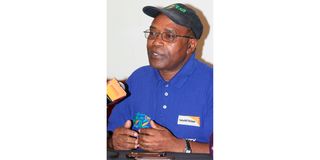Breaking News: At least 10 feared to have drowned in Makueni river
That is not me: Why misidentified and misplaced photos vex readers

Daniel Muthee Ngeera, whom NTV and ‘Nation’ had mistaken for the Rwandan genocide suspect Felicién Kabuga, then on the run, at a press conference on August 6, 2012.
What you need to know:
- Wrong pictures are an irritant to readers and the subjects. Sometimes they can amount to defamation.
- Why do newspapers make such errors? Reasons include the fact that newspapers use large numbers of pictures every time and mistakes are likely to occur when sorting them out.
- However, sloppiness and rashness cannot be ruled out.
Printing wrong pictures—misidentified or misplaced—and botched captions is one of the commonest errors in journalism.
Wrong pictures are an irritant to readers and the subjects. Sometimes they can amount to defamation.
Many of the corrections and apologies made by the Nation on page two are related to wrong pictures.
But this is not peculiar to the Nation; the best of newspapers make such mistakes.
On March 2, 2022, the New York Times used a picture of Serena Williams’s sister, Venus Williams, instead of hers in a story that highlighted her new venture capital fund.
On October 1, 2022, the UK newspaper, The Mirror, used a picture of the wrong person to illustrate a story about Kwasi Kwarteng, a Finance minister in Prime Minister Liz Truss's government.
The paper used, instead, a picture of Bernard Mensah, the president of Bank of America. Both men are black.
Why do newspapers make such errors? Reasons include the fact that newspapers use large numbers of pictures every time and mistakes are likely to occur when sorting them out.
The pictures are also obtained from different sources—including staff photographers, archives, freelancers, correspondents, news sources and visual media companies like Getty Images.
The possibility of a mixed-up or botched picture is high.
However, sloppiness and rashness cannot be ruled out. Probably that was the case with the wrong picture used to illustrate Murang’a Governor Irungu Kang’ata’s story in Tuesday’s Daily Nation.
Its Nairobi and Central Kenya edition published a wrong picture purporting to be that of Dr Kang’ata’s and NHIF CEO Peter Kamunyo signing an MOU for the provision of medical cover for Murang’a residents.
The picture—reportedly taken by Lucy Wanjiru—was that of Mombasa Governor Abdulswamad Nassir being escorted out of the county assembly by Speaker Aharub Khatri.
The same picture—this time reportedly taken by Kevin Odit—was correctly used in another story in the Coast edition headlined “Nassir officially opens the third assembly of Mombasa County”.
Not complained
The error in using a Mombasa picture for a Murang’a story has not been corrected.
I suspect Governor Kang’ata, who also writes a column for the Sunday Nation, has not complained.
In the Wednesday Daily Nation (Nairobi and Central Kenya edition), the right picture of Dr Kang’ata and Mr Kamunyo was used and the story repeated—this time in greater detail under the headline “Kang’ata’s Sh6,000 plan to boost county’s population”.
Perhaps, only the Public Editor and historians will ever complain.
There have been other stories that used wrong pictures with more serious consequences.
For example, the Daily Nation of October 10, 2011, published the photograph of Mrs Mona Staussi instead of that of Mrs Edda Wanjiru Mbiyu under the headline “Koinange widow seized over land activist killing”.
The caption said she was arrested in connection with the murder. You can imagine the embarrassment that caused Mrs Staussi, her family and friends.
Kabuga mix-up
But the most impactful wrongly used picture was that of Daniel Muthee Ngeera.
NTV and Daily Nation published the picture of the retired civil servant who had a timber yard business in Isiolo, claiming he was Felicien Kabuga.
The government had been accused of hiding the Rwandan suspected of financing the 1994 genocide.
NTV aired on July 8 and 15, 2012, a documentary, “In the footsteps of Kabuga”.
In it, investigative journalist John Allan Namu claimed he had found Kabuga hiding in Isiolo!
The Daily Nation also published articles based on the documentary, claiming that the picture was that of Kabuga.
Mr Ngeera sued NMG, claiming that publishing his picture as that of Kabuga damaged his name and standing in society.
He said he was made to suffer great embarrassment and psychological torture because of the misidentification.
In a judgment on June 27, 2019, Justice Lucy Njuguna awarded him Sh6 million as general and punitive damages plus costs for the suit (See Daniel Muthe Ngeere v Nation Media Group Limited & another [2019] eKLR).
Wrong pictures should always be corrected because, if they are not, they remain a historical record.
And readers value a newspaper that honestly corrects itself for the mistakes it makes.
The Public Editor is an independent news ombudsman who handles readers’ complaints on editorial matters including accuracy and journalistic standards. Email: [email protected]. Call or text 0721989264.





